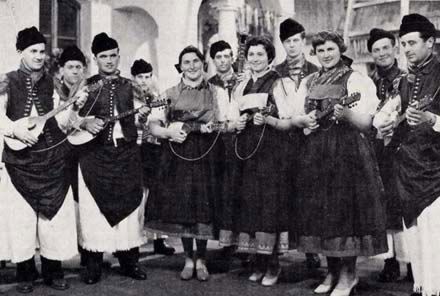|
|
|
Magyarisation, Economy, Assimilation |
|
Attempts at MagyarisationThe Hungarian government’s intensive attempts between 1879 and 1918 to spread the Hungarian language and to suppress minority languages, through massive Magyarisation actions in schools and bureaus, had only moderate success. The results of the 1920 census reported that only 26.8% of the entire Burgenland population had verbal and written command of the Hungarian language. The intellectual elite, in particular priests and teachers, were educated mostly in Hungarian and were considered pro-Hungarian. Economy and Social Structure
In Middle and South Burgenland, in contrast, 67% of the population worked in agriculture. A considerable problem for Croatians in the First Republic was the question of real estate reform. Despite the fact that agricultural and forest land had been worked and improved by Croatians, it remained in the hands of Hungarian and German-Austrian landowners. The tiny properties belonging to Croatians measured only 2-5 hektare while Hungarian and Austrians owned thousands of hektare of land. The organization of co-operatives using the Raiffeisen model had only a little more success than the real estate reform. Many Croatians were forced to migrate. Assimilation Tendencies in AustriaOne off the greatest difficulties for the new Burgenland was, that the larger cities, which until then had been local centers for trade, administration and politics, stayed in Hungary. The newly organized German administration and the German national propaganda, through the Südmark school board, brought about an assimilation stimulus. The attitude of the Croatian population during the 1920/1921 annexation of Burgenland to Austria was one of anxiety. On the one hand, they were nervous about industrial fields and markets being reduced by Austria, who was economically stronger. On the other hand, they feared losing their Croatian language elementary schools under Austrian education laws. The Austrian Elementary School Law envisioned a strict division of church and state. For many it seemed the existence of the Catholic Croatian elementary schools was endangered. Because of this, the Croatian Culture Association "Hrvatsko kulturno društvo", founded in 1920, handed the Border Commission a Memorandum, under the leadership of clerically conservative teachers and priests, which demanded the Croatian localities remain in Hungary. As a result, when the new borders were solidified, Croatian localities lying directly on the border with around 10,000 inhabitants remained part of Hungary. The four languages of Burgenland (Romanian, Hungarian, Croatian, and German) experienced a clear shift, after the annexation of Burgenland to Austria, from Hungarian to German as the most important official language. The new hierarchy of languages was soon internalized by Burgenland inhabitants of all language groups. Because of the pressure to have better command of German than Croatian, there is an observable regular decrease in competence of minority groups in their mother tongue, a marginalization of the importance of ethnic group languages in schools and education, and finally a cultural and ethnic assimilation, closely related to the loss of the native language, which still exists today. to be continued..... |
|
|
by Johannes Graf |
2010.12.17 |

